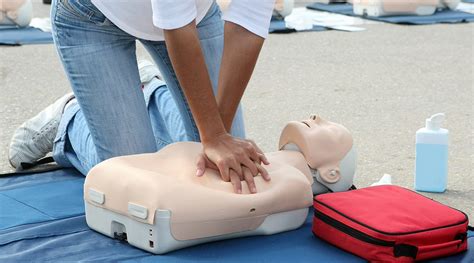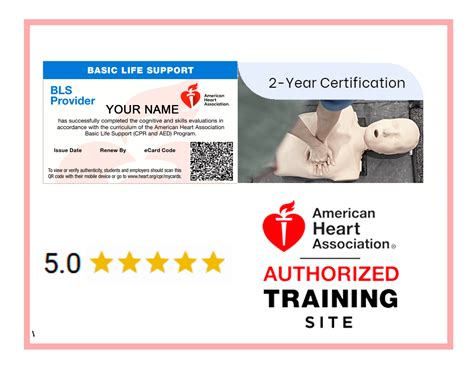Intro
Get certified in lifesaving skills with the American Heart Associations (AHA) BLS Certification program. Learn cardiopulmonary resuscitation (CPR), automated external defibrillator (AED) use, and relief of choking. This article guides you through the certification process, course format, and benefits of becoming BLS certified, ensuring youre equipped to respond in emergencies.
The American Heart Association (AHA) is a leading authority in the field of cardiovascular health, and its certification programs are highly respected in the medical community. One of the most popular certifications offered by the AHA is the Basic Life Support (BLS) certification. In this article, we will explore the importance of BLS certification, the benefits of obtaining it from the AHA, and what to expect from the certification process.

The Importance of BLS Certification
BLS certification is essential for healthcare professionals, including doctors, nurses, paramedics, and emergency responders. The certification demonstrates that an individual has the knowledge and skills necessary to provide high-quality care in emergency situations. BLS certification covers a range of topics, including cardiac arrest, stroke, and choking, as well as the use of automated external defibrillators (AEDs) and bag-valve-mask (BVM) ventilation.
Benefits of AHA BLS Certification
There are several benefits to obtaining BLS certification from the AHA. These include:
- Improved patient outcomes: By learning the latest techniques and guidelines for BLS, healthcare professionals can improve patient outcomes in emergency situations.
- Enhanced career opportunities: BLS certification is a requirement for many healthcare jobs, and having the certification can enhance career opportunities.
- Increased confidence: BLS certification can increase confidence in one's ability to provide high-quality care in emergency situations.
The BLS Certification Process
The BLS certification process typically involves a combination of classroom instruction and hands-on training. The AHA offers a range of BLS courses, including:
- BLS Provider Course: This course is designed for healthcare professionals who need to obtain BLS certification. The course covers a range of topics, including cardiac arrest, stroke, and choking.
- BLS Renewal Course: This course is designed for healthcare professionals who need to renew their BLS certification. The course reviews the latest techniques and guidelines for BLS.
What to Expect from the BLS Certification Course
The BLS certification course typically covers a range of topics, including:
- Cardiac arrest: The course covers the latest techniques and guidelines for cardiac arrest, including the use of AEDs and BVM ventilation.
- Stroke: The course covers the latest techniques and guidelines for stroke, including the use of thrombolytic agents.
- Choking: The course covers the latest techniques and guidelines for choking, including the use of back blows and abdominal thrusts.

Course Format
The BLS certification course is typically offered in a classroom format, with a combination of lectures and hands-on training. The course is usually taught by experienced instructors who are certified by the AHA.
Course Length
The length of the BLS certification course varies depending on the format and the provider. Typically, the course is 4-6 hours long.
Course Cost
The cost of the BLS certification course varies depending on the provider and the format. Typically, the course costs between $50-$200.
How to Maintain BLS Certification
BLS certification is valid for two years, and healthcare professionals must renew their certification every two years to maintain their certification. The AHA offers a range of renewal courses, including online courses and classroom courses.

Renewal Course Format
The renewal course is typically offered in a classroom format, with a combination of lectures and hands-on training. The course is usually taught by experienced instructors who are certified by the AHA.
Renewal Course Length
The length of the renewal course varies depending on the format and the provider. Typically, the course is 2-4 hours long.
Renewal Course Cost
The cost of the renewal course varies depending on the provider and the format. Typically, the course costs between $25-$100.
Conclusion
BLS certification from the American Heart Association is an essential certification for healthcare professionals. The certification demonstrates that an individual has the knowledge and skills necessary to provide high-quality care in emergency situations. By obtaining BLS certification, healthcare professionals can improve patient outcomes, enhance their career opportunities, and increase their confidence in their ability to provide high-quality care.
We hope this article has provided you with a comprehensive understanding of BLS certification from the American Heart Association. If you have any questions or comments, please feel free to leave them below.
What is BLS certification?
+BLS certification is a certification program that demonstrates that an individual has the knowledge and skills necessary to provide high-quality care in emergency situations.
Who needs BLS certification?
+BLS certification is required for many healthcare jobs, including doctors, nurses, paramedics, and emergency responders.
How long is BLS certification valid?
+BLS certification is valid for two years, and healthcare professionals must renew their certification every two years to maintain their certification.
